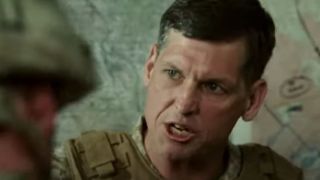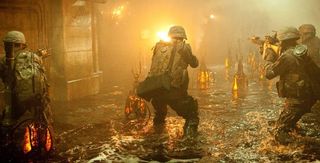Battle: Los Angeles Set Visit Reveals A Gritty Aaron Eckhart And Deadly Alien Pods

A cluster of gray buildings on the outskirts of Baton Rouge, Louisiana, Celtic Media Center looks for all the world like an old Coca-Cola bottling plant--because it is one. Retrofitted for Hollywood production thanks to Louisiana's generous tax credits and a resulting filmmaking boom, the center still looks as ordinary and drab as any average manufacturing plant-- that is, until a ball of fire erupts from behind a wall.
Because for the past few months the Celtic Media Center hadn't been home to Coca-Cola bottles but to a destroyed southern California, setting of the alien invasion/war movie Battle: Los Angeles. As we approached the set on a chilly, early December day the filming had moved outside, as a group of determined Marines did battle against an evil alien force that, for the moment, was being represented by a big orange balloon floating in the distance. The destruction was pure movie magic-- styrofoam rubble, broken-down buildings revealed as mere scaffolding, even palm trees shipped in from who knows where. But the action itself, which included star Aaron Eckhart and a handful of other cast members, felt surprisingly real. Sure they were firing blanks and starting down an absent enemy, but the screams and the intensity felt honest take after take; at one point when Eckhart jumped down from some concrete to shoot from a different angle, he faceplanted in the dirt but gestured the director to keep filming.
"I don't even go up to Aaron any more and go, 'Are you OK?" confessed director Jonathan Liebesman later that afternoon, with his actor sitting next to him and doing just fine. "He doesn't want a medic, and I go to him and I don't even ask if he wants one. I say let's go back to playback and see." Eckhart is by far the biggest name in an enormous cast that includes Michelle Rodriguez, Michael Pena, Bridget Moynahan and even rapper Ne-Yo, but his passion for the movie is far more than that of an actor picking up a star's paycheck. When Liebesman was first pitching the project to Sony, Eckhart joined him on the studio's Hollywood back lot to shoot test footage; the initial plan had been to shoot six or so shots, and according to Liebesman, "we ended up shooting I think 100 and something setups." Though none of the footage will wind up included in the final film-- Eckhart underwent a lot of training afterward to get in proper Marine shape-- the studio at one point considered keeping it in.

Within minutes of arriving on set we were watching the big scene, then shaking hands with a grubby and energetic Eckhart during a break before he and everyone else was called back to set with, of all things, the theme from Magnificent Seven (hey, whatever keeps you going). But while the battle raged on it was time to get a look at the rest of the indoor sets, which were taking up the entire, enormous complex-- Battle: Los Angeles at the time was the biggest film to shoot almost entirely in Louisiana. With only one week of filming taking place in Los Angeles itself the production had recreated southern California in the lowcountry, shooting everywhere from a freeway to a Baton Rouge neighborhood called Spanishtown that made a perfect stand-in for the streets of L.A. Our first stop on the set was the team's precise recreation of a Spanishtown street, complete with garbage cans and hanging powerlines, that led into a somewhat dilapidated apartment complex surrounding a kidney-shaped pool. The apartments weren't a recreation of anything real, but a meticulously designed set that would host an intense battle scene between our team of Marines and one of the aliens who had touched down in their city.
The next set, in a warehouse just a few yards over, comes into play near the finale of the film; just before the climactic scene we saw them shooting outside, the Marines tramp through the Los Angeles sewer system in knee-deep water, past mysterious amber-glowing pods that serve an important but unexplained (to us, at least) purpose for the aliens. We donned thigh-wide wading boots to walk through the tunnels, constructed out of fiberglass but looking for all the world like a worn-out sewer system-- even the water was a convincingly gross shade of brown. The tunnel they had built was fairly complex in its twists and turns, but movie magic will heighten that even more in the final product; as production designer Peter Wenham explained as he walked us through the set, "This tunnel kind of doubles up for three sets. We revamp it and redress it, coming from different angles and directions. They ultimately end up, disappear up a ladder somewhere." He told us about the locations they've shot on-- the Shreveport freeway, the streets of Spanishtown and described a production designer's challenge that also makes for a thrilling action movie: "There's no going back to any location like normal storytelling. This is a continual journey that doesn't stop from start to finish."
With the aliens literally kept under wraps the whole time we were there-- physical models were draped under sheets, and of course there was plenty of CGI work left to come-- the Marines became the focus of what we saw and talked about. It didn't take long to learn that Battle: Los Angeles isn't an alien movie with soldiers, but a war movie that happens to include aliens. Eckhart and the rest of the actors playing Marines underwent weeks of boot camp training, and everything about the shoot from camera angles to plot went toward making this Marine platoon feel as true to life as possible. As actor Noel Fisher, who plays rookie Private Lanahan, put it in a roundtable interview later, "We've spent four months now together. We go out, we work out, we go for dinner. These are our boys now, which is what a Marine platoon would hopefully be." Even though Eckhart's character is older than the others and therefore a little bit separate, he went through every bit of the hellish training alongside them; "He was running around with his M-16 past when we were a lot of the time. Fully doing it," explained Taylor Handley, who plays surfer kid Lance Corporal Simmons.

And watching Eckhart refuse to yell "cut" even when he'd fallen on his face was all part of the process Jonathan Liebesman used to capture battle scenes in realistic and gritty ways; inspired by video games like Modern Warfare as well as the input from military adviser Sgt. Jim Dever, Liebesman has brought his camera operators into the middle of the action, emphasizing both the kinetic energy of the scene and the confusing fog of war that happens when fighting human enemies, much less aliens. Explains producer Jeffrey Chernoff, "To keep it real we want to shoot continuously and quickly and keep it in camera, and keep the whole energy moving forward. There's been a bit of a sacrifice, but it's not going to hurt the look of the movie or the feel of it. You saw today, we shoot. There's no bounce boards or silks or anything. It's going to feel very, very real."
CINEMABLEND NEWSLETTER
Your Daily Blend of Entertainment News
Liebesman, who was disappointed when his last film The Killing Room went straight to video, was open about the fact that Battle: Los Angeles marked an important step forward-- but wasn't about to call it a redemption. "I worked out of redemption on my last film and it went straight to video," he explained. "I think what I'm doing now, I'm just super passionate about the film. If you had a microphone with me and Aaron every day on set, all we talk about is how can we make this film as great as possible. And that's really what I've focused on. If the redemption comes from that, that's great. But it's not as important to me as it was in my 20s, when it was so important to be like my idols. Now I realize, I think, you're on your own path."
That path, as it turns out, wound up leading Liebesman to direct Wrath of the Titans, taking the helm of a brand-new franchise worth many hundreds of millions even before Battle: Los Angeles hits theaters. On that set in December 2009 Liebesman was brutally honest about what the movie's success or failure would mean for his career-- "If this one fucks up, everyone's going to think I suck for the rest of my life. I'll be stuck in Suckville forever." And even though no audiences have seen Battle: Los Angeles yet, some producers somewhere got enough of a look to trust Liebesman on something even bigger-- strong evidence that neither Liebesman or the audience who pays for this movie will be anywhere near Suckville.

Come back tomorrow for more of our interview with Eckhart and the rest of the cast, plus producers Jeffrey Chernoff and Ori and the always candid Liebesman. Battle: Los Angeles opens March 11; here's one more slightly profane promise from Liebesman about why it'll be worth seeing:
"Yes there's been some recent alien movies that are super successful and great films. But people here are rising to the challenge every fucking day with passion, and at the end of the day if you're going to plunk down your $10, $12 or whatever the amount of money will be when it comes out, you would've had 300 people working passionately on a movie for like a year and a half, as hard as they fucking can."
Staff Writer at CinemaBlend
Most Popular






